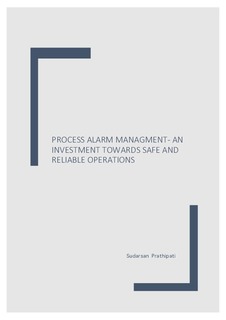| dc.description.abstract | Most of the commercial buildings and private homes are configured with a certain number of alarms to deal with emergency situations, such as fire alarms, HVAC fail alarms, theft alarms, water leakage alarms etc. However, for an industrial process plant, all alarms and their configuration parameters collectively feed into a big database. For a typical offshore installation, the alarm database for the integrated control and safety system may consist of 40000 to 150000 alarms which must be monitored.
Considering the vastness of an alarm database for a process installation, and the risk of missing critical alarms, there is a need for a regulated and a guided system to handle and integrate all aspects of alarm engineering to create a functional alarm system. Such an alarm system must:
• Be built on “principles of alarm design” for process industries
• Be complaint with applicable regulations
• Be usable by process operators in management of abnormal situations
• Perform in line with organisational performance measures
As process industries are getting increasingly complex, with new technologies and expansion projects, process operators are becoming overloaded with new systems and new alarms dominate the unnecessary disturbance. Alarm systems need to be well specified and maintained to ensure safe operations.
During the period between August 2000 and September 2002, NPD (Norwegian Petroleum Directorate) has carried out the supervision of alarm systems on seven production facilities within the Norwegian Continental Shelf. Authorised mapping of alarm systems revealed essentially the same weaknesses and same problem areas, independent of system vendor, operating company, type of facility and age of device. Despite the limited mapping that has been made, NPD find it reasonable to assume that, the results from these activities are somewhat representative of the challenges of other facilities on the Norwegian continental shelf.
This thesis will choose to provide a proactive approach to draft various procedures for a functional alarm system with all the specifics mentioned above for an alarm system within the frame work of regulations limited to Norwegian continental shelf.
A well-functioned alarm system combines with coordinated operations management can drive not only
safety and ensure regulatory compliance but promote better plant availability and throughput, delivering
real business value. (Honeywell, 2017) | nb_NO |
